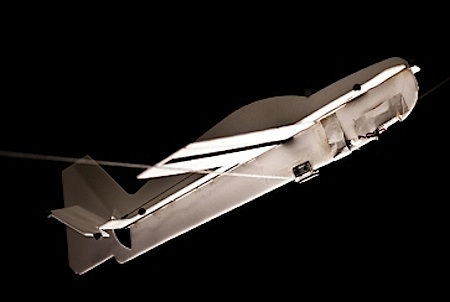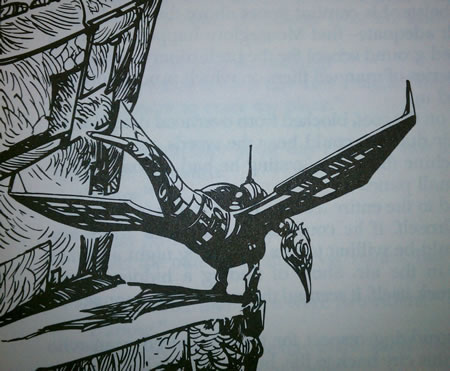Science Fiction
Dictionary
A B C D E F G H I J K L M N O P Q R S T U V W X Y Z
MIT Glider Lands On a Perch Like A Bird

MIT researchers have developed a foam glider that can land on a perch like a parakeet. To match this commonplace avian feat, they had to master the stall, a maneuver that requires the plane to tilt its wings back at a very sharp angle, creating a turbulent air flow that brings the plane to a near halt in mid-air. See the video below for some great slow-motion footage of the MIT glider in flight.

(MIT glider lands on perch)
To design their control system, MIT Associate Professor Russ Tedrake, a member of the Computer Science and Artificial Intelligence Laboratory, and Rick Cory, a PhD student in Tedrake's lab who defended his dissertation this spring, first developed their own mathematical model of a glider in stall. For a range of launch conditions, they used the model to calculate sequences of instructions intended to guide the glider to its perch. "It gets this nominal trajectory," Cory explains. "It says, 'If this is a perfect model, this is how it should fly.'" But, he adds, "because the model is not perfect, if you play out that same solution, it completely misses."So Cory and Tedrake also developed a set of error-correction controls that could nudge the glider back onto its trajectory when location sensors determined that it had deviated from it. By using innovative techniques developed at MIT's Laboratory for Information and Decision Systems, they were able to precisely calculate the degree of deviation that the controls could compensate for. The addition of the error-correction controls makes a trajectory look like a tube snaking through space: The center of the tube is the trajectory calculated using Cory and Tedrake's model; the radius of the tube describes the tolerance of the error-correction controls.
The control system ends up being, effectively, a bunch of tubes pressed together like a fistful of straws. If the glider goes so far off course that it leaves one tube, it will still find itself in another. Once the glider is launched, it just keeps checking its position and executing the command that corresponds to the tube in which it finds itself. The design of the system earned Cory Boeing’s 2010 Engineering Student of the Year Award.
The measure of air resistance against a body in flight is known as the "drag coefficient." A cruising plane tries to minimize its drag coefficient, but when it's trying to slow down, it tilts its wings back in order to increase drag. Ordinarily, it can't tilt back too far, for fear of stall. But because Cory and Tedrake's control system takes advantage of stall, the glider, when it's landing, has a drag coefficient that's four to five times that of other aerial vehicles.
I'm always impressed by research that brings the dreams of science fiction authors to life. For example, consider the biomimetic tracer-bird from Roger Zelazny's excellent 1980 novel Changeling, illustrated by Esteban Maroto. This device could easily land on a high perch to perform its surveillance duties.

"He saw the blue-bellied, gray-backed thing upon the sill overhead. It was turned as if watching them. A portion of its front end caught the sunlight and cast it down toward them... The tracer-bird followed their every step, hung upon their words..."
(From Changeling by Roger Zelazny)
See what Stanford engineers are doing on the other side of the country in Perching Project Drones Wait For You . Read more details about the perching glider at the MIT press release.
Scroll down for more stories in the same category. (Story submitted 10/11/2010)
Follow this kind of news @Technovelgy.| Email | RSS | Blog It | Stumble | del.icio.us | Digg | Reddit |
Would
you like to contribute a story tip?
It's easy:
Get the URL of the story, and the related sf author, and add
it here.
Comment/Join discussion ( 0 )
Related News Stories - (" Engineering ")
Roborock Saros Z70 Is A Robot Vacuum With An Arm
'Anything larger than a BB shot it picked up and placed in a tray...' - Robert Heinlein, 1956.
Secret Kill Switch Found In Yutong Buses
'The car faltered as the external command came to brake...' - Keith Laumer, 1965.
The Desert Ship Sailed In Imagination
'Across the ancient sea floor a dozen tall, blue-sailed Martian sand ships floated, like blue smoke.' - Ray Bradbury, 1950.
The Zapata Air Scooter Would Be Great In A Science Fiction Story
'Betty's slapdash style.'
Technovelgy (that's tech-novel-gee!) is devoted to the creative science inventions and ideas of sf authors. Look for the Invention Category that interests you, the Glossary, the Invention Timeline, or see what's New.
Science Fiction
Timeline
1600-1899
1900-1939
1940's 1950's
1960's 1970's
1980's 1990's
2000's 2010's
Current News
Golf Ball Test Robot Wears Them Out
"The robot solemnly hit a ball against the wall, picked it up and teed it, hit it again, over and again...'
Boring Company Vegas Loop Like Asimov Said
'There was a wall ahead... It was riddled with holes that were the mouths of tunnels.'
Rigid Metallic Clothing From Science Fiction To You
'...support the interior human structure against Jupiter’s pull.'
Is The Seattle Ultrasonics C-200 A Heinlein Vibroblade?
'It ain't a vibroblade. It's steel. Messy.'
Roborock Saros Z70 Is A Robot Vacuum With An Arm
'Anything larger than a BB shot it picked up and placed in a tray...'
A Beautiful Visualization Of Compact Food
'The German chemists have discovered how to supply the needed elements in compact, undiluted form...'
Bone-Building Drug Evenity Approved
'Compounds devised by the biochemists for the rapid building of bone...'
Secret Kill Switch Found In Yutong Buses
'The car faltered as the external command came to brake...'
Inmotion Electric Unicycle In Combat
'It is about the size and shape of a kitchen stool, gyro-stabilized...'
Grok Scores Best In Psychological Tests
'Try to find out how he ticks...'
PaXini Supersensitive Robot Fingers
'My fingers are not that sensitive...'
Congress Considers Automatic Emergency Braking, One Hundred Years Too Late
'The greatest problem of all was the elimination of the human element of braking together with its inevitable time lag.'
The Desert Ship Sailed In Imagination
'Across the ancient sea floor a dozen tall, blue-sailed Martian sand ships floated, like blue smoke.'
The Zapata Air Scooter Would Be Great In A Science Fiction Story
'Betty's slapdash style.'
Thermostabilized Wet Meat Product (NASA Prototype)
There are no orbiting Michelin stars. Yet.
Could Crystal Batteries Generate Power For Centuries?
'Power could be compressed thus into an inch-square cube of what looked like blue-white ice'
